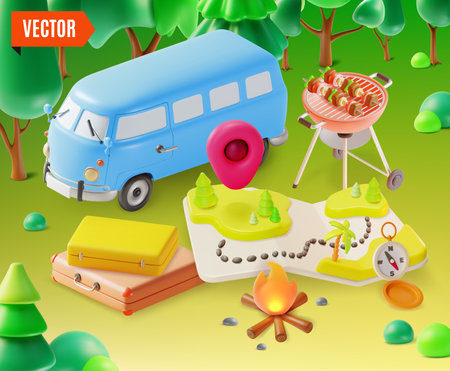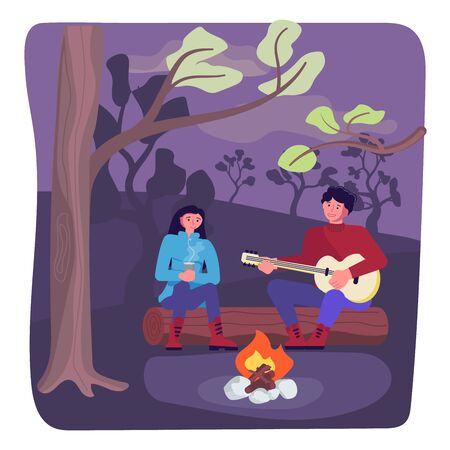1. Choosing the Right RV for Your Family
Planning your first RV camping trip with kids is exciting, but choosing the right RV can feel overwhelming at first. There are several types of recreational vehicles to consider, and each offers different features that may or may not suit your familys size, lifestyle, and travel goals. Heres a breakdown of the most common RV types to help you make the best choice.
Types of RVs
| RV Type | Description | Best For |
|---|---|---|
| Class A Motorhome | Large, bus-like vehicle with plenty of space and amenities. | Large families looking for comfort and long-term travel. |
| Class C Motorhome | Mid-size motorhome with a sleeping area over the cab. | Families who want a balance between space and drivability. |
| Class B Camper Van | Compact van-style RV with basic amenities. | Small families or couples traveling light and staying mobile. |
| Travel Trailer | Towed by a truck or SUV; offers various sizes and layouts. | Families who already own a capable tow vehicle and want flexibility. |
| Fifth-Wheel Trailer | Larger trailer that connects to a pickup truck via a special hitch. | Larger families seeking more living space and home-like features. |
Consider Your Family’s Needs
When youre traveling with kids, comfort, safety, and convenience should be top priorities. Here are some questions to ask yourself as you narrow down your options:
- How many people are going? Make sure there are enough sleeping areas for everyone to be comfortable—bunk beds are great for kids!
- What kind of trips will you take? Weekend getaways require less space than long cross-country adventures.
- Do you plan on cooking meals? Look for RVs with full kitchens if you plan to cook regularly instead of eating out.
- Will you be driving often or staying in one place? Drivable RVs like Class C are easier for frequent moves; trailers work well if you plan to stay put longer.
Your Budget Matters
The cost of an RV can vary widely depending on type, size, age, and condition. Don’t forget about other expenses like insurance, maintenance, fuel, campground fees, and accessories. Here’s a general idea of price ranges:
| RV Type | Approximate Price Range (New) |
|---|---|
| Class A Motorhome | $100,000 – $300,000+ |
| Class C Motorhome | $70,000 – $150,000 |
| Class B Camper Van | $60,000 – $130,000 |
| Travel Trailer | $20,000 – $60,000 |
| Fifth-Wheel Trailer | $35,000 – $100,000+ |
A Few More Tips When Choosing Your First Family RV:
- Rent before you buy: Try renting different types of RVs through platforms like Outdoorsy or Cruise America to see what works best for your family.
- Create a checklist: List your must-haves (like number of beds or bathroom size) before shopping around.
- Think about storage: With kids come toys, clothes, snacks—you’ll need smart storage solutions!
Selecting the right RV is one of the biggest decisions youll make when planning your first trip. Take your time exploring the options so that when youre ready to hit the road with your family, you’ll be set up for a fun and stress-free adventure.
2. Planning Your Route and Booking Campsites
When youre RV camping with kids, planning your route is more than just picking a destination—its about making the journey fun, smooth, and safe for everyone. The right route and campsites can make or break your trip, especially when little ones are along for the ride.
Tips for Finding Family-Friendly RV Parks
Not all RV parks are created equal. Some are tailored for retirees, while others are packed with kid-friendly amenities like playgrounds, pools, and nature trails. Here’s what to look for:
- Play Areas: Parks with playgrounds or open grassy spaces give kids a chance to stretch their legs.
- Family Bathrooms: These are incredibly helpful when traveling with toddlers or young kids.
- On-Site Activities: Look for movie nights, crafts, or scavenger hunts designed for children.
- Safety Features: Gated entrances and low-speed limits inside the park provide peace of mind.
Helpful Apps for Route Planning
Technology can be your best friend when it comes to planning an RV trip. There are several apps that help you map out your journey, avoid steep grades or low clearances, and find family-friendly stops along the way. Here’s a quick breakdown:
| App Name | Main Features | Why Its Great for Families |
|---|---|---|
| RV LIFE | Custom routing for RV size, campground reviews | Avoids roads unsafe for RVs; includes park ratings from other families |
| The Dyrt | Campsite finder, user reviews, offline access | Easily find kid-friendly campgrounds with real photos and tips |
| Roadtrippers | Trip planner with attractions, food stops, and more | Add fun roadside attractions to keep kids entertained between stops |
| Campendium | Campsite locator with filters like hookups and amenities | Filter by family needs like bathrooms, laundry facilities, or pet-friendliness |
Making Sure Your Stops Have What Kids Need
You don’t want to pull into a campsite after hours on the road only to find there’s no bathroom or space to play. Before booking any stop, double-check these essentials:
Amenities Checklist for Kid-Friendly Campsites
- Restrooms & Showers: Clean and easy-to-access facilities make bedtime routines smoother.
- Laundry Services: Accidents happen—having laundry on-site can be a lifesaver.
- Paved Paths or Trails: Great for stroller walks or bike rides.
- Shade & Picnic Areas: Ideal for snack time or outdoor meals without too much sun exposure.
- Noiseless Zones: Quieter areas of the campground help ensure better sleep for the kids—and you!
A little extra planning goes a long way in making your RV adventure enjoyable for everyone in the family. With the right route and well-chosen campsites, your first trip will be full of fun memories instead of unexpected stress.

3. Packing Essentials for Families with Kids
Packing for your first RV camping trip with kids can feel overwhelming, but having a solid checklist makes it easier. You’ll want to bring the right mix of items for comfort, safety, meals, and entertainment. Heres a family-friendly guide to what you should pack to keep everyone happy on the road and at the campsite.
Comfort Essentials
Making your RV feel like home is key, especially when traveling with children. Here’s what youll need:
| Item | Why It’s Important |
|---|---|
| Bedding (sheets, blankets, pillows) | Ensures everyone sleeps comfortably after a long day of activities |
| Kids’ favorite stuffed animals or blankets | Helps children feel secure and sleep better in a new environment |
| Portable fans or space heaters (if needed) | Keeps the temperature comfortable inside the RV |
| Camping chairs and outdoor rugs | Makes outdoor lounging more enjoyable and clean |
Cooking and Dining Gear
Feeding your family on the road is easier when your kitchen is well-stocked. Here are some must-haves:
| Item | Purpose |
|---|---|
| Cookware (pots, pans, utensils) | To prepare meals just like at home |
| Plates, bowls, and kid-friendly cups | Reusable options are eco-friendly and practical |
| Cooler or extra fridge space | Keeps food fresh during longer stays or travel days |
| Snacks and easy-to-make meals | Saves time and keeps kids satisfied between meals |
Safety Must-Haves
Your familys safety always comes first. Don’t leave without these essentials:
- First aid kit: Include band-aids, antiseptic wipes, tweezers, fever medicine, and any prescription meds.
- Flashlights or headlamps: One per person—great for nighttime bathroom trips or exploring.
- Fire extinguisher: Make sure its up to date and easily accessible.
- Sunscreen & bug spray: Protects against sunburns and insect bites.
- Childproofing supplies: Cabinet locks or outlet covers for toddlers.
Kid-Friendly Gear & Entertainment
A bored kid can make even the most scenic RV trip feel stressful. Pack smart with fun in mind:
Toys & Activities for Downtime
- Puzzle books, coloring supplies, card games
- A few favorite toys or action figures
- Lego sets in small containers or travel-sized board games
Outdoor Fun Equipment
- Bikes or scooters (with helmets!) for campground cruising
- Bubbles, chalk, frisbees, or a ball for open areas
- Campsite scavenger hunt list to encourage exploration
Digital Entertainment (in moderation)
- Tablet loaded with movies or educational apps—don’t forget headphones!
- Audiobooks or kid-friendly podcasts for long drives
- Portable DVD player if you don’t have built-in screens in the RV
Packing might take some effort upfront, but having all these essentials ready will make your RV adventure smoother and way more enjoyable for everyone involved.
4. Keeping Kids Engaged During the Journey
Long drives in an RV can be a big adventure, but for kids, sitting still for hours can quickly lead to boredom and fussiness. To keep everyone happy during your RV trip, it helps to plan ahead with a mix of fun activities, snack options, and screen time balance.
Travel Games to Play on the Road
Classic road trip games are a great way to pass the time and bond as a family. Here are some fun and simple games that work well in an RV:
| Game | How to Play |
|---|---|
| I Spy | One person says “I spy with my little eye…” and gives a clue about something they see inside or outside the RV. Others guess what it is. |
| License Plate Game | See how many different state plates you can spot. Keep track on paper or use a printable map. |
| 20 Questions | One person thinks of something, and others ask yes/no questions to figure out what it is within 20 tries. |
| The Alphabet Game | Find words starting with each letter of the alphabet in order by looking at road signs, billboards, or store names. |
Balancing Screen Time Wisely
Screens can be helpful tools for long rides, but too much screen time can lead to cranky moods or eye strain. Set clear guidelines before hitting the road. For example:
- Create screen time blocks: Allow screens only during certain hours or after completing non-screen activities like reading or drawing.
- Use educational apps: Download learning games or documentaries that match your childs interests.
- Headphones are key: Make sure each child has their own set so everyone can enjoy their entertainment without bothering others.
Snack Organization Tips
A well-stocked snack station keeps tummies full and reduces unnecessary stops. Use clear bins or organizers to make snacks easy to grab and go. Here’s a simple way to organize snacks:
| Snack Type | Examples | Storage Tip |
|---|---|---|
| Healthy Snacks | Sliced apples, baby carrots, trail mix | Keep in small reusable containers in a cooler bag |
| Treats | Fruit snacks, granola bars, mini cookies | Store in labeled bins for easy access |
| Drinks | Juice boxes, water bottles, milk cartons | Use an insulated cooler with ice packs to stay cold |
Create a Travel Routine
Kiddos thrive on routine—even when youre on vacation. Try creating a loose schedule that includes playtime, quiet time, meals, and rest breaks every couple of hours. Having predictable moments during the day can help kids feel more comfortable and less restless while on the road.
A Sample Daily RV Travel Routine:
| Time | Activity |
|---|---|
| 8:00 AM – 9:00 AM | Breakfast and morning prep |
| 9:00 AM – 11:00 AM | Drive with travel games or screen-free activities |
| 11:00 AM – 11:30 AM | Snack break and short walk/stretch stop |
| 11:30 AM – 1:00 PM | Screens allowed (movies or games) |
| 1:00 PM – 2:00 PM | Lunch break at scenic area if possible |
| 2:00 PM – 4:00 PM | Naptime or quiet activity (audiobooks, coloring) |
A mix of activities, movement breaks, and tasty snacks will help ensure your kids stay content—and your journey stays smooth—all the way to your campsite.
5. Safety, Etiquette, and RV Life Basics
When youre heading out on your first RV camping trip with kids, safety and etiquette are just as important as packing snacks and planning fun activities. Teaching your children how to be safe and respectful at a campground sets the tone for a smooth, enjoyable experience for everyone. Plus, learning the basics of RV life helps the whole family feel more comfortable on the road.
RV Safety Tips Every Family Should Know
Before you hit the road, go over some basic RV safety rules with your kids. These simple precautions can prevent accidents and keep everyone safe:
| Safety Tip | Why It Matters |
|---|---|
| Buckle up while driving | RV passengers must wear seatbelts just like in a regular car. |
| Stay seated when moving | Walking around while the RV is moving can lead to injuries. |
| Know emergency exits | Show kids how to open emergency windows or doors in case of an emergency. |
| Keep fire extinguishers handy | Teach older kids how to use them if needed. |
| Practice campfire safety | Always supervise kids around fires and teach them how to safely enjoy one. |
Campground Etiquette for Kids (and Adults)
Respecting others at the campground makes RV camping better for everyone. Teach your kids these simple campground manners:
- Keep noise levels down, especially early in the morning and after dark.
- Don’t walk through other campsites—stay on roads or designated paths.
- Clean up after yourself and dispose of trash properly.
- If you bring pets, keep them on a leash and clean up after them.
- Be friendly! A smile and “hello” go a long way with neighbors.
Good Habits for Daily RV Life
Living in an RV—even for just a few days—is different from being at home. Here are some routines that help your trip run smoothly:
Create a Simple Daily Schedule
Keeps kids on track with meals, playtime, and rest so they don’t get overtired or cranky.
Assign Small Responsibilities
Let younger kids help with easy tasks like setting up chairs or gathering kindling. Older ones can assist with hookups or keeping the interior tidy.
Keep Things Organized
A cluttered RV gets uncomfortable fast. Use bins or shelves to store toys, clothes, and gear so everything has a place.
Practice Water & Power Conservation
Explain that water tanks and batteries aren’t unlimited—short showers, turning off lights, and not leaving faucets running are good habits to learn early.
Quick Tip:
Create a “camping rules” list together before your trip and post it inside the RV where everyone can see it. This helps kids take ownership of their behavior and builds excitement for their new adventure!


